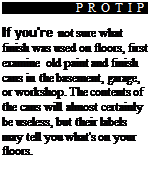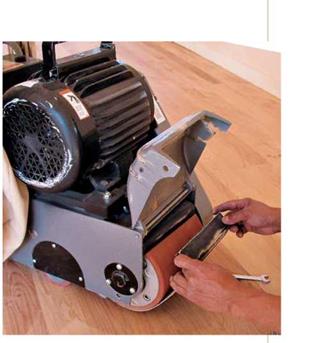Refinishing Wood Floors
Wood floor refinishing can be as simple as lightly sanding an existing finish and applying another coat of the same finish or as extensive as stripping the floor finish completely and sanding it several times before applying a new finish. If the floor is just grimy and dull from too many coats of wax, it may just need a thorough washing.
If washing doesn’t do the trick, try to determine what the existing finish is before you rent a sander.
THREE TESTS TO DETERMINE A FLOOR FINISH
Wood floors installed in the 1960s or earlier were usually finished with some combination of wax, shellac, and varnish. After that, they were most likely finished with a penetrating oil, or oil – or water-based polyurethane. (For more on finishes,
see p. 494.) Here are a few tests to help figure out what’s there, and what to do next.
Test 1: Wax. Place several drops of water on the floor: If the surface turns white in 10 minutes or 15 minutes, there’s wax on the floor. If the water doesn t leave a white spot, try Test 2. If the finish is dull, try cleaning it with a wax cleaner. If scratches and scuffs are limited, wax will be reasonably easy to remove by applying wax stripper or mineral spirits and wiping up the residue. Then apply a new coat of wax. However, if floors are badly abraded and can’t be buffed out, sand the floors, refinish them with a penetrating stain, and then wax them. Even if you sand wax – sealed floors down to bare wood, wax clinging to board edges may prevent a nonwax finish from adhering properly. (Get a second opinion from a professional floor refinisher.)
Test 2: Shellac or varnish. Find an area where the finish is poor shape and scrap it with your thumbnail or a penny. If the finish flakes off, it’s shellac or varnish, which were good in their day but should now be sanded off completely and replaced with polyurethane. If the finish doesn t flake, try Test 3. If the abraded areas are small, try restoring damaged areas by lightly sanding them, vacuuming and dust-mopping them well, then applying a new coat of finish. If there’s not too much sanding to do, you may not need to rent a sander: A random orbital sander with 100-grit or 120-grit sandpaper should do the job. Use a natural-bristle brush or a lamb’s wool pad to apply shellac or varnish.
 Test 3: Polyurethane. In an inconspicuous place, brush on a small amount of paint stripper. If the finish bubbles, it’s polyurethane. If it doesn’t
Test 3: Polyurethane. In an inconspicuous place, brush on a small amount of paint stripper. If the finish bubbles, it’s polyurethane. If it doesn’t
|
|
|
|
|
|
|
|
|
|







Leave a reply